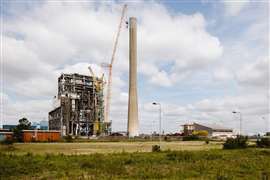Read this article in Français Deutsch Italiano Português Español
Green road construction: What are the newest developments?
08 January 2024
Manufacturers in road construction are thinking green when it comes to materials and alternative fuels. The journey to net zero is underway, and the developments in equipment and tech are increasingly advanced, reports Katherine Weir.
The road construction sector seems to be one of the busiest in the industry, with governments worldwide investing hundreds of billions in new roads and their maintenance. The CEO of one of the sector’s largest OEMs sees this strong demand continuing in the future, although some regions will see larger growth than others.
“The industry outlook for the road building sector currently predicts remaining flat, but we also notice a strong demand in the road segment in the US, thanks to the government’s investment program in infrastructure,” comments Dr. Volker Knickel, CEO at Wirtgen Group.
“There are signs of recovery on the horizon in China since the government has started to launch stimulus packages. The Indian market has come out strong this year, and this trend is expected to continue into 2024.”
Varied market conditions
The Wirtgen Group CEO says that there is good development in the Latin American market, in particular Brazil. However, in Europe, road construction companies are still ‘a little reluctant’ to invest for reasons such as rising costs to build roads and hesitation due to geo-political issues.
 Rubbermix asphalt is a crumb rubber solution that gives an alternative recovery option for used tyres by incorporating them into asphalt mixes (Photo: Cemex UK)
Rubbermix asphalt is a crumb rubber solution that gives an alternative recovery option for used tyres by incorporating them into asphalt mixes (Photo: Cemex UK)
“We are convinced that road construction projects can be realised quickly, economically, and sustainably with Wirtgen Group’s innovative, economical, and sustainable technologies. Our customers can work profitably, and in the end, this also stimulates investment in new equipment,” he says.
Cemex works with local authorities and governments across the globe on road construction and so is well placed to comment on the sector.
Marcelo Catala, vice president of urbanisation solutions for Cemex EMEA, says, “In our EMEA region, we run paving operations in the UK, Spain, Poland, Croatia, Egypt, and the UAE. A particularly important part of our operation is the UK, where we supply a variety of asphalt solutions.
“Recent key projects have included partnering with Liverpool County Council on a carbon reduction road re-surfacing programme, providing our carbon neutral asphalt product, Vialow Zero.”
Earlier this year in Spain, Cemex’s Vertua cement was supplied for the last section of the A33 motorway. A stretch of 16km, part of the A33 motorway that runs between the municipalities of Blanca, in Murcia, and Fuente la Higuera, in Valencia, aims to be ‘the most innovative and sustainable’ highway in Spain.
Catala says, “The solution was a continuous reinforced concrete pavement built in two layers, chosen by National Transport Ministry – the owner of the road – as it is the most economical throughout the entire lifecycle of the pavement; a useful life of 30 years, although these pavements usually provide useful lives of 50 years and even longer.”
Klara Entlerova, MarCom specialist for heavy compaction, trench rollers, and light tandem rollers at Ammann, says that demand has been consistently high, globally, since the restrictions associated with Covid ended.
“This heightened demand can be attributed to several factors, including government investments in new road projects and the maintenance of existing infrastructure,” says Entlerova. “The pandemic significantly affected various industries, but we’ve observed a notable recovery in the road construction sector during this period, which has contributed to the sustained high demand for our services.”
Scott Pedersen, vice president of engineering, research and development at US-based concrete paving technology company GOMACO, says it has seen an increase in demand for pavers, placers, and texturing and curing machines in the last few years, and signs for next year are positive.
Lowering emissions
“GOMACO believes that reducing emissions will continue to be an important factor moving forward. We have released the CC-1200e as the world’s first fully electric curb machine,” says Pederson. “It is powered by a 48-volt DC lithium-ion battery pack, which allows for zero exhaust emissions, reduced vibrations, and zero engine noise.”
Catala at Cemex agrees that sustainability and emissions have increased in importance. “Over the past few years, we have seen more attention paid to sustainability than ever before, as a global construction materials company working across many product areas,” he says.
“We believe that climate action is the biggest challenge of our time, and the construction industry has a clear role to play in this effort.”
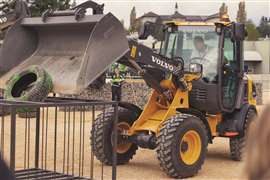 Volvo CE showed off its electric machines at its annual Operators Club Final this October (Photo: Volvo CE)
Volvo CE showed off its electric machines at its annual Operators Club Final this October (Photo: Volvo CE)
Cemex has a ‘Future in Action’ program that includes a climate action strategy, defining a global target to achieve 47% CO2 reduction per ton of cementitious material by 2030 compared to 1990 levels.
“Action has already resulted in CO2 emissions across our global portfolio reducing by 30% since 1990, and in Europe by around 41%,” says Catala.
“Globally, we have achieved a 35% alternative fuel substitution rate, with investment taking place across the business to improve this. In two years, we have reduced specific emissions by 9%, a reduction that in the past took more than a decade to achieve.”
Efficient engines and new tech
Emissions reduction is also increasingly important to Ammann, explains Entlerova. “We address this on a variety of fronts. First, we ensure the use of efficient engines and technologies; second, various solutions improving productivity.”
Ecodrop is an initiative that is carried out across the Ammann product line, including fuel efficiency. The company has also engineered machines that require lower fluid levels, saving natural resources and ‘drastically reducing’ the resulting waste materials.
Entlerova says, “The proprietary Ammann Compaction Expert (ACE) system is available as an option. The system allows easy monitoring of compaction progress for operators and helps them to control the compaction process; meeting compaction goals in fewer passes, which burns less fuel and emissions.”
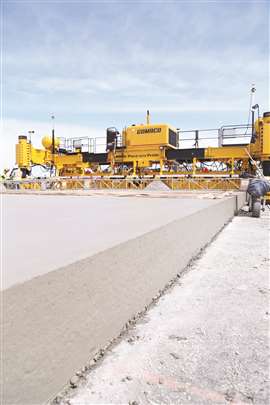 The Gomaco GP4 four-track slipform paver at work on an airport runway paving 37.5 feet (11.4 m) wide, 17 inches (432 mm) (Photo: GOMACO)
The Gomaco GP4 four-track slipform paver at work on an airport runway paving 37.5 feet (11.4 m) wide, 17 inches (432 mm) (Photo: GOMACO)
Alternative power sources such as electricity can be expected at Ammann, as well as the use of Hydrotreated Vegetable Oil (HVO), a biofuel made from waste. “HVO has been approved for Ammann machines,” says Entlerova. “It is a quick and easy step towards net zero goals and reduces gas CO2 emissions by up to 90%, with no additional cost. HVO is classed as a renewable diesel.”
This biofuel can also be used in the majority of Liebherr machines. Liebherr-Werk Ehingen has been fuelling its mobile and crawler cranes solely with HVO fuel since September 2021. The manufacturing giant says that HVO’s manufacture is climate-neutral if electricity is solely generated from renewable energy sources. In addition, it generates fewer emissions than a machine operated with fossil diesel fuel.
HVO is something that Wirtgen see as a key tool in the sector’s fight to reduce emissions. “Transition fuels like HVO will play a major role in the short and medium term to decarbonise job sites. Diesel engines will remain on the market for years but could run with alternative fossil-free fuels where available,” says Dr. Knickel.
He adds, “We have implemented cost-saving, environmentally friendly, and future-oriented production processes that ensure efficient and resource-friendly operations at all German brand headquarters and international production locations.”
Tech-focused sustainability
Self-driving vehicles are a widespread reality in agriculture – could they be technically possible in road construction?
“Two examples where this has been realised is the Wirtgen AutoPilot 2.0, which has allowed automatic paving of monolithic profiles such as concrete safety barriers or the curbs around traffic islands for quite some time,” says Dr Knickel. “Secondly, the new Wirtgen AutoTrac automatic steering system that allows recyclers or soil stabilisers to be steered based on a previously determined reference strip.”
However, the CEO is quick to point out that this technology is, “Not to replace the operator, but to enable them to do their job even better.”
Trimble recently announced that it has completed its first test of a fully autonomous soil compactor on a live job site.
The Trimble Earthworks Grade Control Platform for Autonomous Compactors was tested on a Dynapac CA 5000 soil compactor on the Site C Clean Energy Project on the Peace River in northeast British Columbia, Canada.
This is said to be one of the industry’s first public tests of a fully autonomous compactor on a live construction site.
Trimble says that the fully autonomous machine completed 37 hours of real compaction work, operating alongside a mixed fleet of compactors, the rest of which were running the Trimble CCS900 Compaction Control System.
Data from all machines – both with and without an operator – were delivered using Trimble WorksOS Software, which is being used as the system of record.
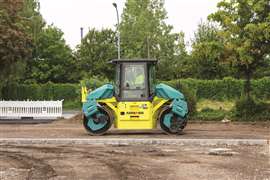 The machines in Ammann’s e-drive compaction product line produce zero emissions whilst delivering productivity (Photo: Ammann)
The machines in Ammann’s e-drive compaction product line produce zero emissions whilst delivering productivity (Photo: Ammann)
“The Site C project was the perfect place to begin live testing of the fully autonomous soil compactor because of the cost and safety benefits autonomy will bring to large infrastructure projects like this in the future,” said Cameron Clark, earthmoving industry director for Trimble’s civil infrastructure solutions.
For Ammann, electrification is the key to new technology on its road construction equipment. Its eMission is described by the manufacturer as an environmentally friendly solution integrated into its equipment. Benefits are said to include zero emissions, improved profits through reduced maintenance costs, and ‘high performance’ because of expansive battery capacity and its vibratory solution.
“We offer several e-drive compaction products, including rammers, plates and a tandem roller,” says Entlerova.
Modern urbanisation
Cemex’s urbanisation solutions business is innovating to help meet the challenges of modern urbanisation. “We have been investing heavily in the development of new solutions used in our road surfacing operations across Europe,” says Catala.
Products that carry the company’s Ventura brand must meet strict sustainable criteria, such as its lower carbon asphalt ‘innovation’ with a new bio-component binder which locks carbon into asphalt.
“This reduces the carbon footprint of the bitumen by up to 250 kilograms of CO2e when compared with conventional bitumen, which in turn reduces the CO2e in the asphalt by as much as a third,” explains Catala.
“The solution involves the addition of biogenic components engineered to ensure bitumen compatibility that won’t compromise the performance characteristics of asphalt. The end-result is an asphalt that can be recycled whilst also retaining captured bio-carbon.”
The company are also looking at ways to support the circular economy by using recycled materials in asphalt solutions, such as a solution that incorporates used tyres into asphalt mixes.
GOMACO has developed machine-to-machine communication that allows the paver operator to adjust the height of the placer, and to ensure the paver always has the correct amount of material in front of the machine.
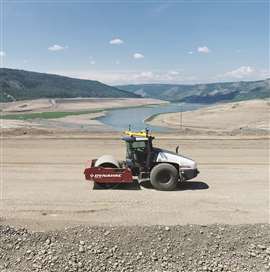 Trimble has completed its first test of a fully autonomous soil compactor on a live job site (Photo: Trimble)
Trimble has completed its first test of a fully autonomous soil compactor on a live job site (Photo: Trimble)
“We are constantly working towards paving the smoothest roads possible. We are always watching for emerging technologies to assist us in achieving this goal,” says Pederson.
The company anticipates more sensors throughout the entire paving process in the future for greater quality control.
Reaching net zero
Predictions on the future are hard to give with so many different factors at play.
“Current trends suggest a continued focus on digitalisation and electrification in various industries,” says Entlerova. “However, the specific directions and breakthroughs in technology will depend on a multitude of variables, making it hard to definitively state what forms it may take.”
For Cemex, developing the use of recycled materials and reducing the carbon footprint of the production process is key. “We think that ongoing innovation will be crucial if we are to reach net zero as a business, and indeed as a wider industry,” says Catala.
“A circular economy is essential for environmental sustainability. By transforming waste materials into invaluable solutions, carbon emissions are reduced along with other environmental benefits.”
STAY CONNECTED


Receive the information you need when you need it through our world-leading magazines, newsletters and daily briefings.
CONNECT WITH THE TEAM









